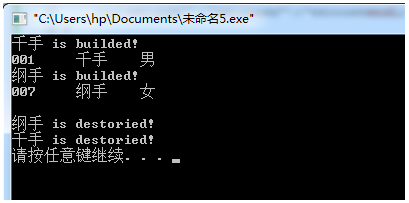构造函数和析构函数 深入解析C++中的构造函数和析构函数
人气:0想了解深入解析C++中的构造函数和析构函数的相关内容吗,在本文为您仔细讲解构造函数和析构函数的相关知识和一些Code实例,欢迎阅读和指正,我们先划重点:构造函数,析构函数,下面大家一起来学习吧。
构造函数:
在类实例化对象时自动执行,对类中的数据进行初始化。构造函数可以从载,可以有多个,但是只能有一个缺省构造函数。
析构函数:
在撤销对象占用的内存之前,进行一些操作的函数。析构函数不能被重载,只能有一个。
调用构造函数和析构函数的顺序:
先构造的后析构,后构造的先折构。它相当于一个栈,先进后出。
复制代码 代码如下:
#include<iostream>
#include<string>
using namespace std;
class Student{
public:
Student(string,string,string);
~Student();
void show();
private:
string num;
string name;
string sex;
};
Student::Student(string nu,string na,string s){
num=nu;
name=na;
sex=s;
cout<<name<<" is builded!"<<endl;
}
void Student::show(){
cout<<num<<"\t"<<name<<"\t"<<sex<<endl;
}
Student::~Student(){
cout<<name<<" is destoried!"<<endl;
}
int main(){
Student s1("001","千手","男");
s1.show();
Student s2("007","纲手","女");
s2.show();
cout<<"nihao"<<endl;
cout<<endl;
cout<<"NIHAO"<<endl;
return 0;
}

先构造的千手,结果后析构的千手;后构造的纲手,结果先折构的纲手。
特点:
在全局范围定义的对象和在函数中定义的静态(static)局部对象,只在main函数结束或者调用exit函数结束程序时,才调用析构函数。
如果是在函数中定义的对象,在建立对象时调用其构造函数,在函数调用结束、对象释放时先调用析构函数。
复制代码 代码如下:
#include<iostream>
#include<string>
using namespace std;
class Student{
public:
Student(string,string);
~Student();
void show();
string num;
string name;
};
Student::Student(string nu,string na){
num=nu;
name=na;
cout<<name<<" is builded!"<<endl<<endl;
}
void Student::show(){
cout<<num<<"\t"<<name<<endl<<endl;
}
Student::~Student(){
cout<<name<<" is destoried!"<<endl<<endl;
}
void fun(){
cout<<"============调用fun函数============"<<endl<<endl;
Student s2("002","自动局部变量");//定义自动局部对象
s2.show();
static Student s3("003","静态局部变量");//定义静态局部变量
s3.show();
cout<<"===========fun函数调用结束=============="<<endl<<endl;
}
int main(){
Student s1("001","全局变量");
s1.show();
fun();
cout<<"\nthis is some content before the end\n";//这是一段位于main函数结束之前,函数调用之后的内容
cout<<endl;
return 0;
}

加载全部内容